 When we think about safety hazards in the home, most of us probably don’t give our house’s plumbing a second thought. Certainly, it doesn’t seem to pose the kinds of immediate risks that your home’s electrical or natural gas delivery systems do. However, if something goes wrong with your hot water heater, pipes, valves or faucets, it can lead to serious damage.
When we think about safety hazards in the home, most of us probably don’t give our house’s plumbing a second thought. Certainly, it doesn’t seem to pose the kinds of immediate risks that your home’s electrical or natural gas delivery systems do. However, if something goes wrong with your hot water heater, pipes, valves or faucets, it can lead to serious damage.
Some of that damage might be obvious—a ceiling collapsing from a water leak in a second-story bathroom, for example–but other damage might not be so apparent. Slow leaks can cause rot and mold. They can also put your home’s electrical wiring and gas lines at risk. These potential problems aside, some materials used in the plumbing of older homes may also present health concerns for the people for the people living there. Following are some ways to avoid possible plumbing-related health hazards in your home and to ensure that your plumbing system is safe.
- Your hot water heater should be set no higher than 120°F to prevent you and your family from being burned. There should also be an automatic anti-scald feature built into each shower head to prevent water from getting too hot.
- Hot water heaters can be gas, electric, oil or propane types. If using a gas or propane hot water heater, it should be properly vented with either direct venting or power venting. This is important to avoid the buildup in your home of poisonous gases such as carbon monoxide (CO) that are the result of gas combustion. You can buy a carbon monoxide inspection kit from your local home improvement store to periodically check CO levels, or have a professional come to do it for you. CO emissions should not be higher than 5ppm near the water heater, and exhaust emissions should not register higher than 100ppm, apart from the first 30 seconds after starting up.
- If you seem to be paying for more water than you are using, you may have a leak. Look for signs of leaks such as rust, water marks and buckling. Check under sinks, and under and around your water heater, washing machine and dishwasher to pinpoint the source of the leak.
- The main shut-off valve for water to the building should be easily accessible in case a pipe bursts so that your home is not flooded.
- Lead pipes in an older home are not the only potential source of toxic exposure. Brass fittings can also be a problem. A study done by researchers at Virginia Tech found that some brass products used in plumbing systems leached hazardous levels of lead into drinking water. Brass is a copper alloy that contains a number of other metals, including lead. To reduce your risk of excessive lead intake, consider replacing any brass fittings or fixtures with those that use a safer alternative such as copper or plastic materials.
- Your plumbing materials, such as piping, should be marked with the code “NSF-PW” or “NSF-61.” This indicates that the materials are certified according to the NSF/ANSI Standard 61 guidelines for the safety of materials that come into contact with potable water. If it does not have this code, or is marked as “NSF-DWV,” it should not be used for any potable water instillations.
Keeping these few plumbing safety tips in mind will help to ensure that your home is safe and comfortable for you and your family.














